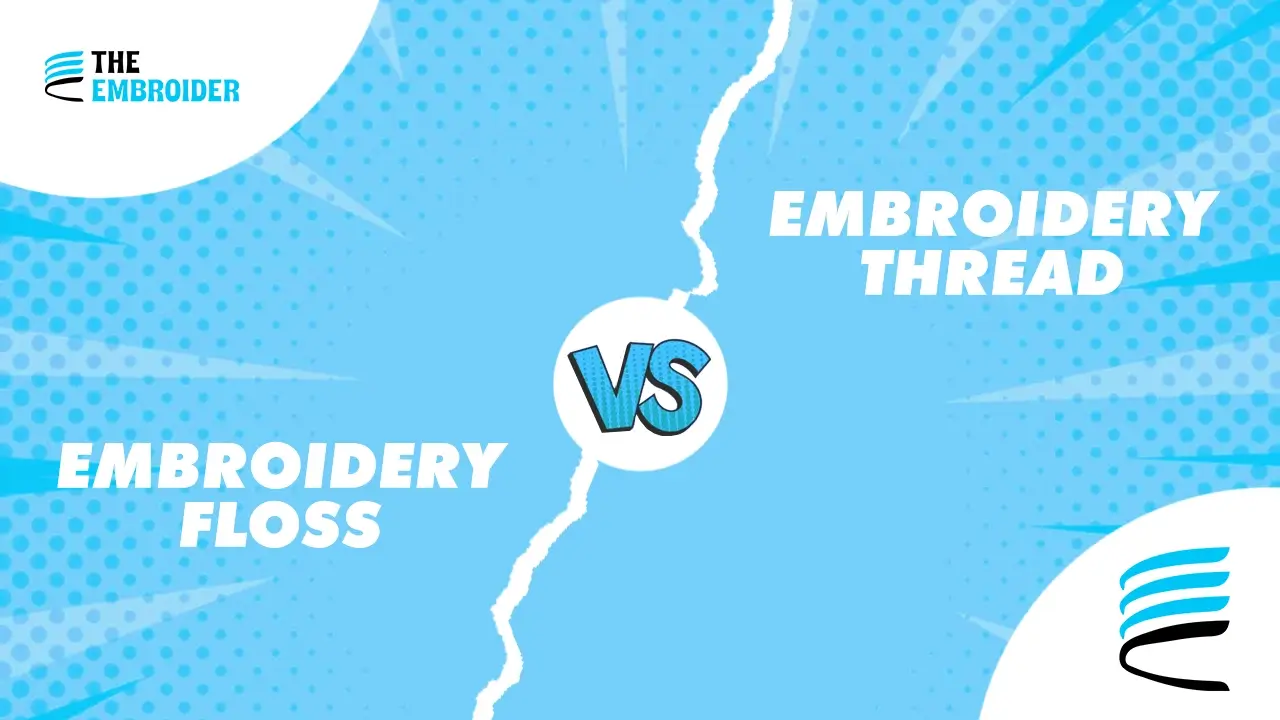Embroidery enthusiasts often face the dilemma of selecting the appropriate thread for their projects. Even though there are several options, embroidery thread, and floss are two choices in the broader spectrum. Therefore, a lot of people want to know the differences between these two options.
Embroidery thread and floss are both used in embroidery, but they have distinct characteristics. Embroidery thread is typically made of a single strand of thread, while embroidery floss consists of multiple strands that can be separated. Understanding these differences is essential for your embroidery success.
The choice of thread can significantly impact the outcome of your embroidery’s final look. It affects the texture, durability, and overall appearance of your stitches. So, let’s dive into the factors that differentiate embroidery thread from floss.
Differences between Embroidery Thread and Floss
Selecting the embroidery raw material decides the quality and fineness of your final design. Thus, in order to make an informed choice, you must understand the fundamental differences between embroidery thread and floss. Here are some key distinctions:
Composition and Thickness
Embroidery thread is typically crafted from various materials and is single-stranded. Its single-strand nature gives it a sleek and polished appearance. This makes it an excellent choice for designs that require fine detailing and a single-strand look.
In contrast, embroidery floss consists of multiple strands, usually six, that can be separated as needed. This versatility in strand separation allows for a variety of textures and thicknesses in your embroidery work. It’s perfect for projects that demand added dimension and a wider color spectrum.
Read More: How To Thread A Needle For Embroidery
Availability of Colors
When it comes to colors in embroidery, the choice between embroidery thread and embroidery floss plays a significant role. Embroidery thread offers a good variety of colors, making it suitable for many embroidery projects. However, it might not be the best option when you need very specific or unique shades.
In contrast, embroidery floss provides a wide range of colors, allowing you to explore intricate color choices and blend them seamlessly. This expansive color palette can take your embroidery to new creative levels. For instance, if you want to recreate the warm and dusky tones of a unique sunset, the broader color options of embroidery floss come in handy to achieve the desired effect. While you won’t find those shades in embroidery thread.
Usage:
The type of thread you choose can significantly affect the appearance of your stitches. Embroidery thread, with its single-stranded structure, imparts a neater and less bulky look. This characteristic makes it an excellent choice for lightweight fabrics and projects where achieving a finer, more delicate finish is the goal.
In contrast, embroidery floss, with its multi-strand composition, introduces a more substantial and textured feel to your stitches. This added thickness is particularly well-suited for projects that demand a more noticeable three-dimensional effect and a fine quality. It enhances the overall visual and sensory appeal of your embroidery work. This is perfect for puff embroidery and 3D shaded embroidery.
Cost Considerations
The cost of embroidery materials is a factor that many embroiderers take into account. Here’s what you should consider regarding cost:
Embroidery Thread: Typically, embroidery thread tends to be slightly more expensive than floss. The price may vary based on the material, brand, and the number of thread spools or cones in a pack. However, it’s essential to remember that higher-quality threads may cost more, but they offer superior performance and color retention, which can be beneficial in the long run.
Embroidery Floss: Embroidery floss is generally more budget-friendly. It’s available in skeins or hanks, which are cost-effective options for those who embroider frequently or prefer to have a wide color selection. While it’s more affordable, the quality of cotton floss is still excellent, making it a popular choice for both beginners and experienced embroiderers who want to balance quality and cost.
When considering cost, it’s essential to weigh the price against the specific requirements of your project. High-quality materials can make a significant difference in the longevity and vibrancy of your embroidery.
Pros and Cons of Using Embroidery Thread Vs Embroidery Floss
Each embroidery utensil has its perks. They have variable uses. So, before making your choice, let’s explore the advantages and disadvantages of using both embroidery threads and floss.
Advantages of Using Embroidery Thread
- Ideal for delicate designs.
- Gives a neat and polished look even with single-stranded designs
- Suitable for lightweight fabrics.
Read More: What is Vector Tracing Service
Disadvantages of Using Embroidery Thread
- Might not offer the exact shade you need.
- May not provide the desired thickness for some projects and denser designs
Advantages of Using Floss
- It’s Available in a very extensive color range. Thus, it offers a higher opportunity for creativity and color blending.
- Adds dimension to your embroidery and is suitable for thicker designs.
- Suitable for all sorts of fabric types.
Disadvantages of Using Embroidery Floss
- Separating strands of embroidery floss is a tougher task.
- Not ideal for very fine details and single-stranded designs.
Conclusion
In conclusion, the choice between embroidery thread and floss depends on your specific embroidery project and personal preferences. Where embroidery Thread is Best for fine details and a single-stranded look embroidery Floss is ideal for texture, thickness, and a broad color range.
Hence, when choosing between the two, consider the nature of your project and experiment with both types of thread. Your choice of thread can transform your embroidery from ordinary to extraordinary.

